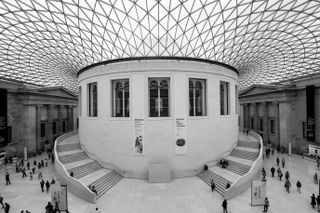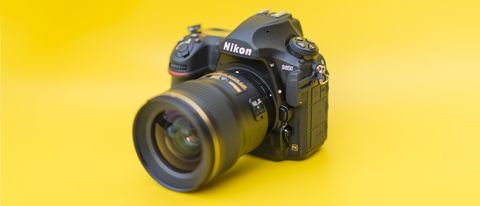Hvorfor du kan stole på TechRadar
Performance
- 7fps burst shooting (9fps with battery grip)
- 51 shot raw file buffer
- 1,840-shot battery life
Despite the decent increase in pixels over the D810, the Nikon D850 features an increased burst shooting speed, up from 5fps to 7fps, making it an even more versatile piece of kit.
Furthermore, attach the optional MB-D18 battery grip to the D850 with a large EN-EL18B battery (as used in the D5) inserted, and that rate will increase to 9fps. This certainly compares favorably with the 5fps shooting speed of both the Canon EOS 5DS and Sony Alpha A7R II, and considering the size of the files the D850 has to process, the 51-shot buffer (at 14-Bit raws) is also very impressive.
The D850's standard battery is the EN-EL15 – it's the same power pack used by the D810, but Nikon has managed to squeeze even more life out of the battery here to deliver a staggering 1,840-shot life. To put that in perspective, you'd need seven NP-FW50 batteries with the Alpha A7R II to reach anything like the D850's battery capacity, or two LP-E6N batteries with a Canon EOS 5D Mark IV.
Something that's bound to appeal to wedding and social photographers is the D850's ability to utilize an electronic shutter to shoot silently at 6fps in Live View mode. Need more speed? Select the DX crop mode and you can shoot 8.6MP pictures at an impressive 30fps.

The D850 employs a 180K-pixel RGB sensor (the same as the D5's), offering metering down to -3EV. This may not sound like a big deal, but if you're shooting long exposures with ND filters you can now rely fully on the D850’s AE and AF without needing to detach the filter. In our tests, the D850's multi-zone Matrix metering system performed very well under a range of lighting conditions, while the breadth of the camera's dynamic range (more on that in a bit) means you've got a fair bit of leeway should the camera get it wrong.
The D850 features three types of auto white balance to cover you for most scenarios. Auto 0 should faithfully render whites under any light sources, Auto 1 maintains a balance of the original subject color and ambient lighting, while Auto 2 renders colors with a natural sense of warmth, retaining the color of incandescent lighting.
The optical viewfinder is stunning; it's incredibly large and bright, while the clarity of the rear touchscreen display doesn't disappoint.
Image quality
- ISO64-25,600 (expandable to ISO32-108,400)
- Additional 25.6MP Medium and 11.4MP Small raw file sizes
- Built-in focus stacking
As you'd expect from a sensor packing 45.4 million pixels, the level of detail the Nikon D850 is capable of resolving is impressive. You'll be able to produce large prints rich in detail, although it goes without saying that to make the most of the sensor you'll need the best glass.
When it comes to high-ISO noise performance, again the D850 doesn't disappoint. Images up to ISO3200 display excellent levels of detail, with minimal noise, while at ISO3200 there's barely any luminance (grain-like) noise in images, and no hint of chroma (color) noise.
Push above that to ISO6400, and while luminance noise is slightly more pronounced, it's still very good – we'd be more than happy to shoot at this sensitivity. Even at ISO12,800 and ISO25,600, while noise is more noticeable it's still well controlled, and results are more than acceptable. Above that we'd try to avoid the two extended settings, which see saturation dropping off a tad; however, with some tweaking in Lightroom or similar it might be possible to get a satisfactory result at ISO51,200.

Click here to see the full-size image

Click here to see the full-size image

Click here to see the full-size image

Click here to see the full-size image

Click here for the full-size image

Click here for the full-size image

Click here to see the full-size image

Click here to see the full-size image

Click here to see the full-size image
The D810 has always impressed with its dynamic range performance, and the good news is that despite the extra pixels populating the D850's sensor it appears to be a similar story here. It's possible to severely underexpose a shot and be able to happily recover shadow detail without unwanted noise encroaching on the shot.
Manually shooting focus-stacked images can be a chore, but the D850 introduces a focus shift photography function, which enables it to shoot a sequence of up to 300 frames, while gradually and automatically shifting focus position from the start point to infinity. The shutter release interval can be set from 0-30 seconds, while the focus step width can be selected from 10 levels.
You'll need an image-editing program like Photoshop to then combine the pictures in post-production, but this looks like a great way to quickly shoot highly detailed macro images
Current page: Performance and image quality
Forrige side Build, handling and AF Næste side Verdict and competitionPhil Hall is an experienced writer and editor having worked on some of the largest photography magazines in the UK, and now edit the photography channel of TechRadar, the UK's biggest tech website and one of the largest in the world. He has also worked on numerous commercial projects, including working with manufacturers like Nikon and Fujifilm on bespoke printed and online camera guides, as well as writing technique blogs and copy for the John Lewis Technology guide.
